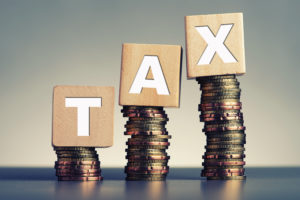In another article, we provided a thorough answer to is the 401k worth it. That article was a general overview of the plan. Here, we zero in specifically into the nuances of 401k withdrawals and loans and why the 401k might not be the best vehicle for building wealth.
Giving additional money to the government in the form of taxes because of a simple oversight is a real drag, and if done consistently can seriously hinder the growth and viability of your retirement account. That’s why it’s important to know the most important rules associated with 401(k) withdrawals and loans.
401k Withdrawals and 401k Loans
The purpose of a 401(k) is to save money for future use, so it’s important to grasp what the law says about accessing your 401(k) money.
There are two basic ways to access the money within your 401(k):
- 401(k) Withdrawals – also known as 401k distributions (the two terms are used interchangeably by the IRS)
- 401(k) Loans
TIP: For each individual 401(k) plan there is a specific set of plan rules and language specified. So if you are reviewing your plan documents you may see a differentiation between withdrawals and distributions. Contact your plan administrator for specifics. But according to the IRS, the two terms are essentially describing the same thing – money coming out of your 401(k) account.
401k Withdrawal Rules
All 401(k) withdrawals are taxed. Why? Because the 401(k) is a tax-deferred account. Meaning that you have not yet paid any tax on the money you put into the account. So you owe tax on both the principle, and any growth.
TIP: You may see some financial advisors suggesting that you can withdraw from your 401k tax-free “if you do it correctly.” These advisors are just saying that your withdrawal is tax free IF your total withdrawal keeps your total income low enough to be considered in the tax-free income bracket. But your withdrawal is still considered regular income by the IRS.
So the only way you keep from paying taxes on your withdrawal is if you have regular income so low in a given year that you are part of the lowest tax bracket.
Here is the main question.
Will you pay a withdrawal penalty to access your money?
This separates all withdrawals into two categories:
- Penalty-Free 401k Withdrawals
- Penalized 401k Withdrawals
First, let’s discuss how to access your money without being penalized. This is what we all want, to access our own money without paying penalties. I know what you’re thinking:
“Why should I be penalized for accessing my OWN money in ANY circumstance?”
Personally, I tend to agree. It’s not fun having rules and penalties regarding accessing your own money, but that’s how the tax-deferred plans work.
And if you choose these 401k plans for retirement, you have to live by the rules or pay the penalty.
This article is about 401k withdrawals and loans, but I do want to mention that there are ways to save for retirement that don’t have these restrictions and penalties, but more on those later.
Penalty-Free 401k Withdrawals
401 k early withdrawal rules allow you to withdraw money without a penalty under certain circumstances listed below. Besides early withdrawals, there are other rules that allow you access to your money without incurring a penalty.
Here are the ways you can access your 401k money penalty free:
- You have reached the age of 59.5
- 401k early withdrawal rules allow penalty free hardship distributions to your money if you are experiencing one of six hardships (listed below is the IRS qualifications for hardship withdrawals)
- 6 Hardship Withdrawals
- Expenses for medical care previously incurred by the employee, the employee’s spouse, or any dependents of the employee
- Costs directly related to the purchase of a principal residence for the employee (excluding mortgage payments)
- Payment of tuition, related educational fees, and room and board expenses, for the next 12 months of postsecondary education for the employee, or the employee’s spouse, children, or dependents
- Payments necessary to prevent the eviction of the employee from the employee’s principal residence or foreclosure on the mortgage on that residence
- Funeral expenses
- Certain expenses relating to the repair of damage to the employee’s principal residence
- Utilizing the various 401k hardship withdrawals have repercussions, such as not being able to pay back the hardship distribution or make salary deferral contributions to your 401k for six months.
- 6 Hardship Withdrawals
- Distributions are made to a beneficiary (or to your estate) on or after your death
- You have a qualifying disability
- Made as part of a series of substantially equal periodic payments (SEPP) beginning after separation from service and made for at least 5 years
- If you have a separation from service, if the separation occurred during or after the calendar year in which you reached age 55
TIP: There are a few other penalty free withdrawals that are a little more obscure, but these are the most common. Also, keep in mind that you are also given a window of time to correct any errors made in contributions during the year. In other words, if you gave too much, you can withdraw the overage without penalty if you do so within a given window.
Taking money out of your 401k without penalty is nice, but keep in mind that most Americans have underfunded 401k accounts that will not provide the lifestyle they desire during retirement.
When you take money out of your 401k, even if it’s penalty-free, you will lose out on the compounding growth in the account. And due to the contribution limits, you may never be able to recoup that lost opportunity.
I mentioned earlier that there are other retirement plans that don’t have the limitations and penalties the 401k plan does. These plans allow you to access the money in the account without losing the compounding growth.
They’re called Cash Value Life Insurance policies, and they’re likely NOT what you’ve heard about in the past. Anyhow, let’s jump on to the other type of 401k withdrawal, the kind that is penalized.
Penalized 401k Withdrawals
Nobody enjoys being penalized, but if you know the rules, you can attempt to avoid the penalties and keep your hard-earned retirement money.
Here are the instances when a withdrawal penalty will incur in the form of an additional tax:
- Withdrawals before the age of 59.5 (that don’t meet the additional criteria listed above) will incur an additional 10% tax on the amount withdrawn
- Withdrawals that do not meet the Required Minimum Distributions (RMDs) after age 70.5 will incur an additional 50% tax on the shortfall of the RMD for retired individuals
Required Minimum Distributions explained: When you turn 70.5 the IRS requires that you start withdrawing money from your tax-deferred accounts. The amount you have to withdraw each year (your required minimum distribution) is a percentage of the total account value. The percentage is determined by considering life expectancy and rate of return.
The IRS wants your account to be depleted in the year you are expected to die, so they can get all their taxes in a timely fashion. If you fail to pay the RMD, you will be taxed a whopping 50% on the amount that you failed to pay, in addition to your normal income tax. Don’t get caught having to pay this! It’s not fun.
As you can see, the IRS is pretty picky about how you access your tax-deferred money. You can’t access it very easily prior to age 59.5, and when you reach 70.5 (perhaps later if you have not yet retired) you’ll be forced to take out the RMD even if you don’t want to or need to.
Is there another option for accessing your 401(k) money? Yes. It’s called a 401k loan.
401k Loan rules
Not all 401k plans allow you to borrow from the plan, so talk to your plan administrator or read your documentation.
A loan from your employer’s 401k plan is not taxable IF it meets the following criteria:
- Generally, if permitted by your plan, you may borrow up to 50% of your vested account balance up to a maximum of $50,000 (Your contributions are always immediately vested. Contributions from your employer may be vested immediately or they may vest over a period of years).
- The loan must be repaid within 5 years, unless the loan is used to buy your main home.
- The loan repayments must be made in substantially level payments, at least quarterly, over the life of the loan.
- You must reduce the $50,000 amount, above, if you already had an outstanding loan from the plan (or any other plan of your employer or related employer)
Loans are not typically taxed, and you won’t incur any penalties. However, you should not take this path unless you have seriously considered your working situation.
If you know you’ll be with your employer for the duration of the loan, you may be fine. You’ll lose the growth of the account, but if you absolutely need the money, it may be a good fit.
If for some reason you leave your employer with an outstanding 401k loan, you’ll typically be given just 60 days to repay the loan in full, and it could then be considered an early withdrawal in which you have to pay the 10% tax. All that to say, it’s risky if you don’t have a very secure job situation.
One last point, all of the above options assume that you want to keep the 401k in place. For those rolling over their 401(k) into another retirement vehicle, there are additional options that have a variety of pros and cons. If you’re interested in learning more about your 401(k), or if you’re interested in utilizing safer, guaranteed, and more flexible retirement options, please give us a call.






